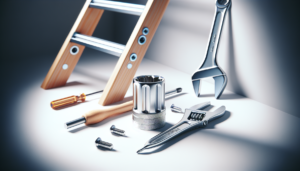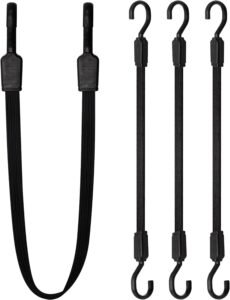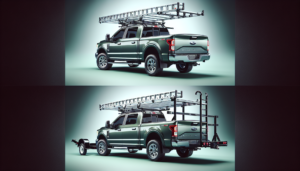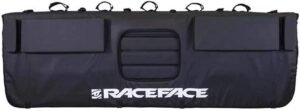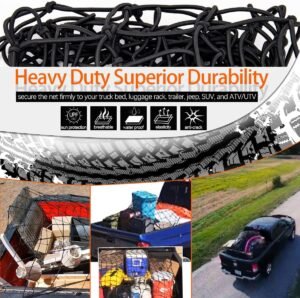If you’re wondering whether a ladder rack is limited to just carrying ladders, you’ll be delighted to know that it can do so much more! Ladder racks are designed to provide a secure and efficient way to transport various materials, not just ladders. Whether you need to haul long pipes, lumber, or even recreational equipment, a ladder rack can be a versatile solution to simplify your transportation needs. Discover the endless possibilities of a ladder rack and unlock its full potential for transporting a wide range of materials with ease and peace of mind.
What is a ladder rack?
A ladder rack is a specially designed structure that mounts onto the roof or bed of a vehicle, allowing you to securely transport ladders or other long and bulky items. It consists of horizontal bars or rails that provide a stable and secure platform to safely carry your materials. Ladder racks are widely used by contractors, tradesmen, and outdoor enthusiasts who need to transport their equipment or gear conveniently and efficiently.
Definition
A ladder rack can be defined as a load-carrying system that is attached to the top or rear of a vehicle to support and secure ladders or other lengthy items during transportation. It is typically made of durable materials like steel or aluminum and is designed to withstand the weight and pressure of the items being carried.
Purpose
The primary purpose of a ladder rack is to provide a safe and efficient means of transporting ladders. However, ladder racks can also be utilized for transporting materials other than ladders. This article will explore the various types of ladder racks, their advantages, considerations for transporting non-ladder materials, alternative options, modifications and accessories, as well as tips for safe transportation.
Types of ladder racks
There are several types of ladder racks available in the market, each catering to different needs and preferences. Understanding the different types can help you choose the most suitable one for your specific requirements.
Fixed ladder racks
Fixed ladder racks are permanently attached to the vehicle’s roof or bed and cannot be easily removed or adjusted. They provide a stable and secure platform for transporting ladders but may not offer the flexibility to carry larger or bulkier items.
Adjustable ladder racks
Adjustable ladder racks, as the name suggests, can be adjusted according to the size of the materials being transported. These racks typically feature telescoping or sliding components that allow you to extend or retract the width and height, providing more versatility and accommodating different load sizes.
Removable ladder racks
Removable ladder racks are designed to be easily installed or removed from the vehicle, offering greater flexibility when you don’t require their usage. These racks typically utilize a quick-release mounting system, allowing you to detach them when not in use.
Over-cab ladder racks
Over-cab ladder racks are a popular choice for pickup trucks and utility vehicles. They extend over the cab of the vehicle, providing additional storage space for longer items while still allowing access to the bed of the truck. These racks are ideal for carrying longer ladders or materials that exceed the length of the vehicle’s bed.
Advantages of using a ladder rack
Using a ladder rack offers several advantages that make it an essential accessory for professionals and individuals who need to transport items such as ladders or other bulky equipment.
Increased storage capacity
One of the primary advantages of using a ladder rack is the increased storage capacity it provides. By utilizing the roof or bed of your vehicle, you can free up valuable interior space, allowing you to transport more equipment or materials. This is particularly beneficial for contractors who often need to carry multiple ladders or other bulky items to job sites.
Efficient organization
Ladder racks enable you to organize and secure your equipment or materials more efficiently. By providing a designated and secure space for your items, it eliminates the risk of them shifting or falling during transit. This not only keeps your vehicle tidy but also minimizes the chances of damage to the items being transported.
Easy access and retrieval
With a ladder rack, you can easily access and retrieve your equipment or materials whenever needed. By securely mounting them on the roof or rear of your vehicle, you eliminate the need to unpack or rearrange items to retrieve a specific ladder or piece of equipment. This saves time and effort, allowing you to focus on the task at hand.
Improved safety
Ladder racks enhance safety during transportation by preventing items from sliding or shifting while on the road. By securing your ladders or materials to the rack, you minimize the risk of them falling off and causing accidents or damage to other vehicles. Additionally, improved safety can also result in reduced liability and insurance costs.
Considerations before using a ladder rack for other materials
While ladder racks are primarily designed for transporting ladders, many individuals may find them useful for carrying other materials or equipment. However, certain considerations must be kept in mind to ensure safe and efficient transportation.
Weight and load capacity
Before using a ladder rack for non-ladder materials, it is crucial to consider the weight and load capacity of the rack. Different ladder racks have different weight limits, and exceeding these limits can compromise the rack’s stability and potentially damage your vehicle. Always check the manufacturer’s specifications and ensure that the combined weight of the materials you plan to transport falls within the recommended limit.
Size and dimensions
The size and dimensions of the materials being transported are another important consideration. While ladder racks can accommodate lengthy items, you need to ensure that the width and height of the materials do not exceed the capacity of the rack or pose a risk of collision with surrounding objects or structures.
Material compatibility
Another consideration is the compatibility of the materials with the ladder rack. Some materials may be prone to damage or may cause damage to the rack if not properly secured. For example, sharp-edged or abrasive materials may require additional padding or protection to prevent scratching or wear on the rack.
Securing and fastening
Securing and fastening the non-ladder materials properly is crucial to ensure safe transportation. It is recommended to use appropriate straps, bungee cords, or other securing mechanisms to prevent the materials from shifting or falling during transit. Ensure that the materials are tightly secured to the rack and that the fasteners or straps are in good condition and can withstand the forces generated during transportation.
Legal regulations
Before using a ladder rack for non-ladder materials, it is essential to familiarize yourself with any legal regulations or restrictions in your region. Some jurisdictions may have specific requirements or limitations regarding the transportation of certain materials or equipment. Compliance with these regulations not only ensures your safety but also helps you avoid any potential fines or legal issues.
Materials that can be transported using a ladder rack
While ladder racks are primarily designed for transporting ladders, they can be utilized for carrying a wide range of materials and equipment. Some common examples include:
Long items
Ladder racks are ideal for transporting long items such as pipes, lumber, or trim pieces, which may be difficult to fit inside the vehicle’s interior. By utilizing the length capacity of the ladder rack, you can transport these materials safely and conveniently.
Bulkier items
Ladder racks offer a stable platform for transporting bulkier items that may be too large or heavy for the vehicle’s interior. This includes items like furniture, appliances, or even large camping gear that require additional space during transportation.
Construction materials
Contractors and builders often use ladder racks to transport construction materials such as drywall, roofing materials, or scaffolding components. These materials can be securely mounted on the ladder rack, allowing for efficient transport to and from job sites.
Sports and recreational equipment
Outdoor enthusiasts can also benefit from using a ladder rack to transport their sports and recreational equipment. Whether it’s kayaks, canoes, bicycles, or surfboards, a ladder rack can provide a secure and convenient solution for safely transporting these items to your favorite outdoor destinations.
Alternative options for transporting non-ladder materials
While ladder racks can be utilized for transporting non-ladder materials, there are alternative options available that may better suit your specific needs and requirements.
Roof racks
Roof racks are similar to ladder racks in that they provide additional storage space on the roof of your vehicle. However, they often offer more versatility and customization options, allowing you to transport a wider range of items. Roof racks typically consist of crossbars and mounting systems that can accommodate various accessories such as cargo boxes, bike racks, or kayak carriers.
Cargo trailers
For individuals who frequently transport large or heavy materials, cargo trailers can be a viable option. These trailers are designed specifically for carrying heavy loads and offer more space and security compared to traditional ladder racks. Cargo trailers come in various sizes and configurations, making them suitable for a wide range of applications.
Truck bed accessories
If you own a pickup truck, utilizing the bed of your vehicle may be a more practical and efficient solution for transporting non-ladder materials. With the right truck bed accessories such as bed liners, tie-down anchors, or cargo management systems, you can safely secure and transport a wide range of items without the need for a separate ladder rack.
Modifications and accessories for using ladder racks with non-ladder materials
If you decide to use a ladder rack for transporting non-ladder materials, there are various modifications and accessories available that can enhance their functionality and safety.
Additional tie-down points
Adding additional tie-down points to your ladder rack can provide more secure fastening options for different types of materials. These tie-down points can be positioned strategically along the rack, allowing you to secure your materials more effectively and minimize any potential movement during transit.
Adjustable brackets and supports
To accommodate different load sizes and shapes, adjustable brackets and supports can be installed on your ladder rack. These accessories allow you to customize the configuration of the rack to securely fit specific items, providing a stable platform for safe transportation.
Panel and sheet carriers
For those who frequently transport large panels or sheets, specialized carriers can be attached to the ladder rack. These carriers are designed to securely hold and protect flat materials such as plywood, drywall, or glass without the risk of damage during transportation.
Cargo nets and straps
Cargo nets and straps are essential accessories for securing loose or bulky materials on your ladder rack. These items help prevent items from shifting or falling during transit, providing an added layer of security and peace of mind.
Tips for safely transporting materials using a ladder rack
Ensuring the safe transportation of materials using a ladder rack requires proper planning and execution. Here are some tips to help you transport your items safely and efficiently.
Proper weight distribution
Maintaining proper weight distribution is vital to ensure the stability and handling of your vehicle. Distribute the weight evenly on your ladder rack, keeping the heaviest items close to the center and ensuring they are securely fastened. This will minimize the risk of imbalanced weight distribution and improve the overall stability of your vehicle.
Secure loading and fastening
Always double-check that your materials are securely loaded and fastened to the ladder rack before hitting the road. Use appropriate straps, bungee cords, or other fastening mechanisms to secure the items tightly, ensuring there is no unnecessary movement or shifting during transit. Regularly check the tightness of the fasteners during breaks or stops to ensure they remain secure throughout the journey.
Clearance and height restrictions
Be mindful of clearance and height restrictions when carrying materials on your ladder rack. Before entering areas such as parking garages, tunnels, or low-hanging obstacles, ensure that the height of your vehicle with the loaded materials does not exceed the clearance. Failure to do so can result in damage to your vehicle, the materials being transported, or potential accidents.
Regular inspections and maintenance
Regularly inspect your ladder rack for any signs of wear, damage, or loose components. Check the fasteners, straps, and other accessories to ensure they are in good condition and functioning properly. Perform routine maintenance, such as lubricating moving parts, tightening bolts, and replacing any worn-out or damaged components.
Consideration of weather and road conditions
Consider the weather and road conditions when transporting materials on your ladder rack. Rain, snow, or strong winds can affect the stability of your vehicle and the secure fastening of the materials. Adjust your driving style accordingly and take extra precautions when encountering adverse weather conditions. Additionally, be cautious of uneven or rough terrain that may impact the stability and security of the materials being transported.
Potential risks and challenges
While using a ladder rack can greatly facilitate the transportation of materials, there are potential risks and challenges that should be acknowledged and addressed.
Imbalanced weight distribution
Improper weight distribution can affect the stability and handling of your vehicle. When using a ladder rack, it is essential to carefully distribute the weight of your materials to prevent imbalances that can compromise your safety on the road. Failure to maintain proper weight distribution can lead to swaying, loss of control, or even toppling over of your vehicle.
Wind resistance and aerodynamics
The added height and bulk of materials on a ladder rack can increase wind resistance and affect the aerodynamics of your vehicle. As a result, this may impact fuel efficiency and the overall driving experience. It is important to drive cautiously and adjust your speed when facing strong winds or adverse weather conditions to counterbalance the impact of wind resistance.
Limited visibility
Having materials loaded on your ladder rack may restrict your overall visibility, particularly when looking through the rearview mirror or checking blind spots. Take extra caution, be aware of your surroundings, and adjust your driving accordingly to compensate for the reduced visibility. Consider using additional mirrors or visual aids to improve visibility if necessary.
Increased vehicle height and stability
When using a ladder rack, your vehicle’s overall height is increased. This can lead to clearance issues, particularly in areas with low overhangs or height restrictions. Additionally, the increased height can also impact the stability of your vehicle, especially when traveling at high speeds or navigating tight turns. Pay extra attention to your vehicle’s stability and adapt your driving style accordingly to minimize the risk of accidents or instability.
Conclusion
While ladder racks are primarily designed for transporting ladders, they can also be a versatile solution for transporting a wide range of non-ladder materials. By understanding the different types of ladder racks, considering their advantages and limitations, and following the necessary precautions, you can safely and efficiently transport your materials. Remember to always adhere to legal regulations, distribute the weight properly, secure the materials tightly, and regularly inspect and maintain your ladder rack to ensure a smooth and trouble-free transportation experience.
